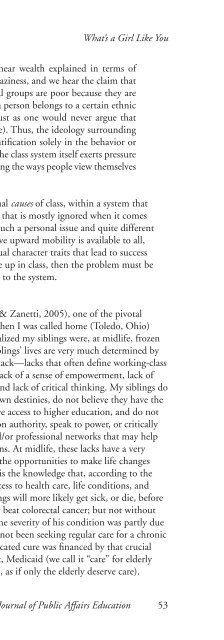WINTER 2012 - National Association of Schools of Public Affairs and ...
WINTER 2012 - National Association of Schools of Public Affairs and ...
WINTER 2012 - National Association of Schools of Public Affairs and ...
You also want an ePaper? Increase the reach of your titles
YUMPU automatically turns print PDFs into web optimized ePapers that Google loves.
LITERATURE REVIEW<br />
Techniques in Teaching Statistics<br />
Teaching Statistics<br />
Because students <strong>of</strong>ten experience anxiety, a sense <strong>of</strong> intimidation, <strong>and</strong><br />
lack <strong>of</strong> motivation when faced with statistics, such courses can be among the<br />
most challenging to teach—<strong>of</strong>ten resulting in similar emotional reactions for<br />
instructors (Calderwood, 2002; Forte, 1995; Schacht & Aspelmeier, 2005).<br />
Traditional statistics education has focused on the knowledge <strong>and</strong> skills<br />
components <strong>of</strong> learning or on the logical <strong>and</strong> physical aspects <strong>of</strong> underst<strong>and</strong>ing<br />
statistics, assuming that the desire to learn statistics or the mitigation <strong>of</strong> the<br />
emotional aspects will follow the acquisition <strong>of</strong> these skills.<br />
The emotional aspects represent the perceived value <strong>of</strong> statistics to students;<br />
they will engage themselves in statistics only if they see value in it (Calderwood,<br />
2002; Snee, 1993; Zanakis & Valenzi, 1997). In past years, scholars have found<br />
evidence to suggest that students do not see the value in statistics. For example,<br />
even after students took a statistics course, Zanakis <strong>and</strong> Valenzi (1997) found<br />
that their interest in the subject <strong>and</strong> perceived worth <strong>of</strong> the subject declined.<br />
Jordan <strong>and</strong> Stroup (1984) suggested that although taking a statistics course may<br />
have resulted in a reduction in student fear <strong>of</strong> the course, it did little to persuade<br />
students <strong>of</strong> its value in the real world. Swanson, Meinert, <strong>and</strong> Swanson (1994)<br />
found that, compared with other core courses in a business curriculum, students<br />
perceive statistics to have little practical value, to be very difficult, <strong>and</strong> to have<br />
only average instructional effectiveness.<br />
In addition to past evidence <strong>of</strong> the perception that statistics has limited<br />
value, there is also evidence to suggest that students experience high anxiety<br />
about the course due to their lack <strong>of</strong> underst<strong>and</strong>ing <strong>of</strong> statistics, the fact that<br />
they are required to take tests in the subject, <strong>and</strong> their limited experience<br />
with using computer s<strong>of</strong>tware for statistical calculations (Zanakis & Valenzi,<br />
1997). It is noted, however, that in the most recent decade, computer usage has<br />
increased substantially both in education settings <strong>and</strong> in general life activities.<br />
Thus, general computer literacy might not represent an obstacle now; but<br />
students quite likely may continue to be unfamiliar with statistical s<strong>of</strong>tware<br />
such as SPSS, STATA, or SAS. Even students who are comfortable with using a<br />
familiar s<strong>of</strong>tware package such as Micros<strong>of</strong>t Excel for tasks like keeping track <strong>of</strong><br />
information may be quite unfamiliar with the data analysis tools <strong>and</strong> statistical<br />
functions in this s<strong>of</strong>tware program (formulas <strong>and</strong> mathematical functions,<br />
histograms, regression analysis, etc.). Math anxiety, lack <strong>of</strong> experience with<br />
specialized statistics s<strong>of</strong>tware, perceived difficulty <strong>of</strong> the subject matter, <strong>and</strong> the<br />
assumption that statistics is not a valuable career or life skill can translate into<br />
student apprehension <strong>and</strong> lack <strong>of</strong> focus, instructor frustration, <strong>and</strong>, ultimately, a<br />
negative learning environment (Schacht & Aspelmeier, 2005).<br />
Journal <strong>of</strong> <strong>Public</strong> <strong>Affairs</strong> Education 111

















